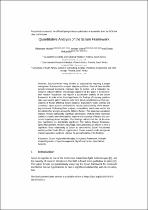JavaScript is disabled for your browser. Some features of this site may not work without it.
- ResearchSpace
- →
- Research Publications/Outputs
- →
- Book Chapters
- →
- View Item
| dc.contributor.author |
Hanslo, Ridewaan

|
|
| dc.contributor.author |
Vahed, Anwar

|
|
| dc.contributor.author |
Mnkandla, E

|
|
| dc.date.accessioned | 2020-05-01T10:09:00Z | |
| dc.date.available | 2020-05-01T10:09:00Z | |
| dc.date.issued | 2020-01 | |
| dc.identifier.citation | Hanslo, R., Vahed, A. and Mnkandla, E. 2020. Quantitative analysis of the scrum framework. Advances in Agile and User-Centred Software Engineering, pp. 82-107. | en_US |
| dc.identifier.isbn | 978-3-030-37534-8 | |
| dc.identifier.uri | https://www.springer.com/gp/book/9783030375331 | |
| dc.identifier.uri | DOI 10.1007/978-3-030-37534-8 | |
| dc.identifier.uri | http://hdl.handle.net/10204/11439 | |
| dc.description | Copyright: 2020 Springer. The attached pdf contains the preprint version of the published item. For access to the published version, kindly access the publisher's website: https://www.springer.com/gp/book/9783030375331 | en_US |
| dc.description.abstract | Scrum provides many benefits to organizations requiring a project management framework for complex adaptive problems. Some of these benefits include improved teamwork, improved time to market, and a noticeable decrease in software defects. The primary objective of this paper is to test nineteen research hypotheses that require a quantitative analysis of the Scrum framework. In order to test these hypotheses, the findings of a survey questionnaire was used to gather response data from Scrum practitioners on their perceptions of factors affecting Scrum adoption. Exploratory factor analysis and Cronbach’s alpha analysis confirmed the validity and reliability of the measuring instrument. Following these analyses, a correlation matrix was used to test the relationship strength among the different factors. The Spearman correlation analysis revealed statistically significant correlations. Multiple linear regression statistical models were developed to examine the existence of factors and constructs impacting Scrum adoption. Our findings indicate that four of the nineteen hypotheses are statistically significant. The factors Change Resistance, Sprint Management, Relative Advantage, and Complexity are shown to have a significant linear relationship to Scrum as perceived by Scrum Practitioners working within South African organizations. Future research could incorporate a larger population sample to improve the generalizability of the findings. | en_US |
| dc.language.iso | en | en_US |
| dc.publisher | Springer | en_US |
| dc.relation.ispartofseries | Worklist;23474 | |
| dc.subject | Scrum | en_US |
| dc.subject | Agile methodologies | en_US |
| dc.subject | Conceptual framework | en_US |
| dc.subject | Multiple linear regression | en_US |
| dc.subject | Project management | en_US |
| dc.subject | Significant factors | en_US |
| dc.subject | Quantitative analysis | en_US |
| dc.title | Quantitative analysis of the scrum framework | en_US |
| dc.type | Book Chapter | en_US |
| dc.identifier.apacitation | Hanslo, R., Vahed, A., & Mnkandla, E. (2020). Quantitative analysis of the scrum framework., <i>Worklist;23474</i> Springer. http://hdl.handle.net/10204/11439 | en_ZA |
| dc.identifier.chicagocitation | Hanslo, Ridewaan, Anwar Vahed, and E Mnkandla. "Quantitative analysis of the scrum framework" In <i>WORKLIST;23474</i>, n.p.: Springer. 2020. http://hdl.handle.net/10204/11439. | en_ZA |
| dc.identifier.vancouvercitation | Hanslo R, Vahed A, Mnkandla E. Quantitative analysis of the scrum framework.. Worklist;23474. [place unknown]: Springer; 2020. [cited yyyy month dd]. http://hdl.handle.net/10204/11439. | en_ZA |
| dc.identifier.ris | TY - Book Chapter AU - Hanslo, Ridewaan AU - Vahed, Anwar AU - Mnkandla, E AB - Scrum provides many benefits to organizations requiring a project management framework for complex adaptive problems. Some of these benefits include improved teamwork, improved time to market, and a noticeable decrease in software defects. The primary objective of this paper is to test nineteen research hypotheses that require a quantitative analysis of the Scrum framework. In order to test these hypotheses, the findings of a survey questionnaire was used to gather response data from Scrum practitioners on their perceptions of factors affecting Scrum adoption. Exploratory factor analysis and Cronbach’s alpha analysis confirmed the validity and reliability of the measuring instrument. Following these analyses, a correlation matrix was used to test the relationship strength among the different factors. The Spearman correlation analysis revealed statistically significant correlations. Multiple linear regression statistical models were developed to examine the existence of factors and constructs impacting Scrum adoption. Our findings indicate that four of the nineteen hypotheses are statistically significant. The factors Change Resistance, Sprint Management, Relative Advantage, and Complexity are shown to have a significant linear relationship to Scrum as perceived by Scrum Practitioners working within South African organizations. Future research could incorporate a larger population sample to improve the generalizability of the findings. DA - 2020-01 DB - ResearchSpace DP - CSIR KW - Scrum KW - Agile methodologies KW - Conceptual framework KW - Multiple linear regression KW - Project management KW - Significant factors KW - Quantitative analysis LK - https://researchspace.csir.co.za PY - 2020 SM - 978-3-030-37534-8 T1 - Quantitative analysis of the scrum framework TI - Quantitative analysis of the scrum framework UR - http://hdl.handle.net/10204/11439 ER - | en_ZA |






